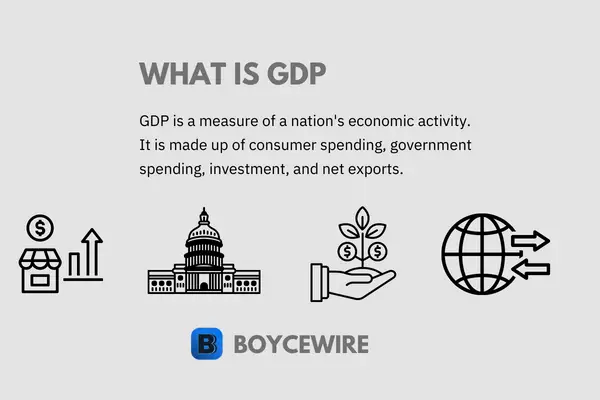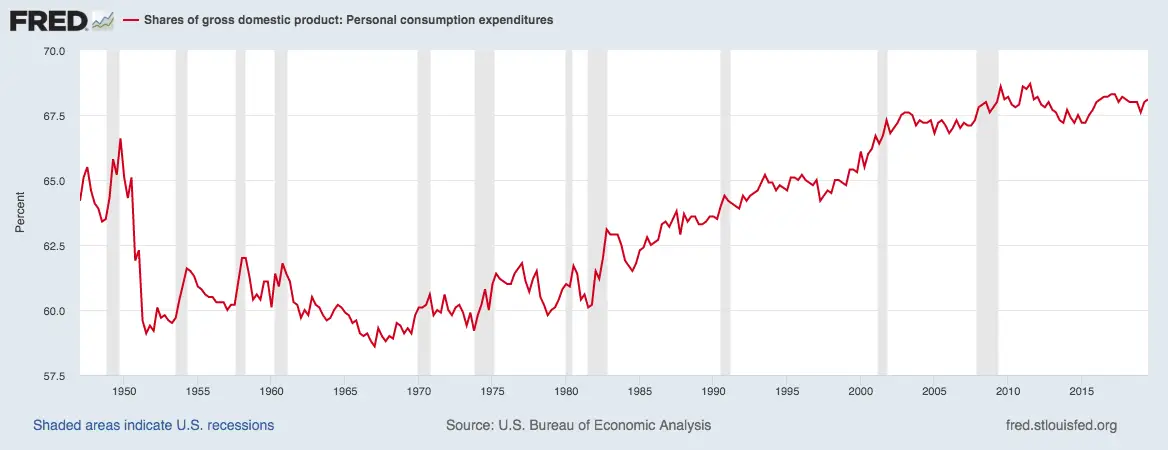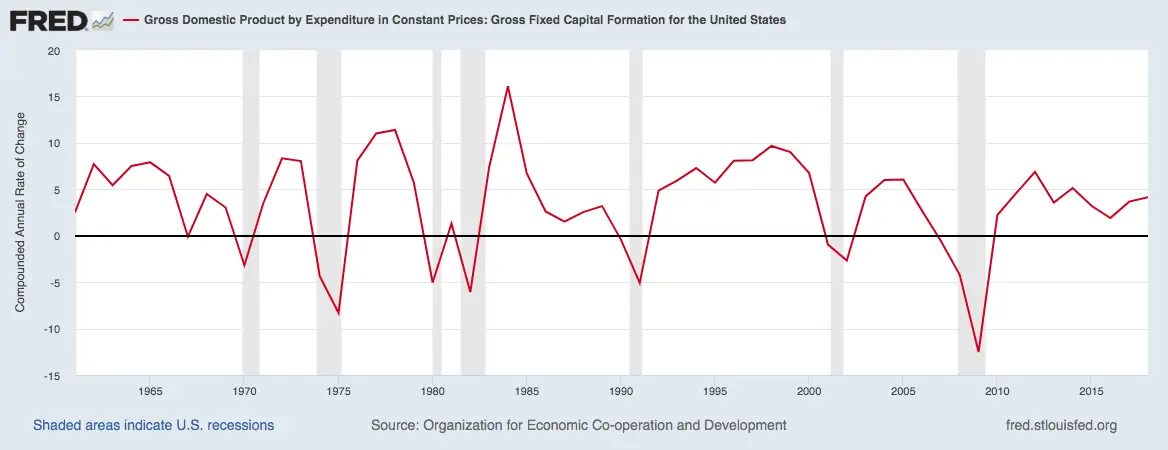GDP: Definition, How to Calculate & Characteristics

What is GDP?
GDP stands for Gross Domestic Product. It simply refers to all the goods and services that a nation produces over a set period of time – calculated in terms of value and local currency. On its own, it may not make much sense. However, when we split it down, it becomes clearer.
First of all, ‘Gross’ has various meanings, but in the case of GDP, it is used as a noun, meaning ‘Complete Amount’. Second of all, ‘Domestic’ comes from the Latin ‘domesticus’, meaning ‘house/home’. In the context of economics, this refers to the ‘home’ nation. Finally, product can be defined as what is produced by labour, or their output.
So putting this together, we arrive at something like ‘Complete amount of output within the home’. In economic terms, this refers to everything a nation produces within a given timeframe.
Key Points
- Gross Domestic Product (GDP) refers to the value of all the goods and service sold in the economy within a set time period.
- Two consecutive quarters of negative GDP growth are classified as an economic recession.
- There are four main components to GDP – Consumption, Investment, Government spending, and Net exports.
GDP Explained
Gross Domestic Product (GDP) measures the overall health of a nation’s economy by calculating how many products/services it makes each year. As a result, it gives a good indication of how businesses are doing.
GDP is an important tool for policymakers because when a nation starts producing fewer goods and services, it shows that something is wrong. Generally speaking, this reflects the ups and downs of the business cycle.
What is GDP used for?
GDP is used to gauge how well the economy is doing which is closely linked to the performance of businesses, profitability, employment, and general economic health. Policymakers use it as an indicator as to when to take action.
Declining GDP would suggest that the economy is doing badly and is in need of stimulus. For example, central banks use declining GDP as a signal to lower interest rates. Elsewhere, politicians may use it as a signal to lower taxes or increase government spending. Both aim at reducing the negative effect of the business cycle, although both have very different results.
When GDP is declining, there are fewer goods being produced in the economy. As the wealth of a nation is dictated by the number of goods it produces, the lower this rate, the lower the wealth it is creating. Therefore, when a nation produces less wealth, the lives of those people in the country will be worse off.
For example, a nation may produce 1,000 oranges in year 1. However, in year 2 it only produces 500 oranges – meaning the nation is poorer as a result of the reduced level of output. It simply means there are fewer goods to go around the economy.
How to Calculate GDP (GDP Formula)
Gross Domestic Product (GDP) is calculated using five elements: Consumption (C); Investment (I); Government Spending (G); and Exports (X) minus imports (M). We can calculate this using the formula:

That is all very well, but how are these elements calculated and what do they include? Let us now look at them below.
Characteristics of GDP
Gross Domestic Product (GDP) is characterised by 4 components: Consumption; Investment; Government Spending; and Net Exports. These all serve to create GDP as a measurement. Let us look at them in more detail below.
What is Consumption (C) in GDP
Consumption is generally referred to as ‘Private Consumption’ – so as not to confuse it with ‘Government Consumption’. For this reason, it includes all purchases made by consumers.
This encompasses a number of purchases such as food, rent, energy, clothing, leisure, education, communication transport, and other services such as hairdressing or insurance. However, the purchase of new houses is counted as an investment.
Anything you spend money on is generally counted as ‘private consumption’. At the same time, there two notable exceptions: capital goods and investment assets.
Capital goods are goods that are used to create final goods for the consumer. In other words, the consumer does not consume them, but rather they are part of the production process to create further consumer goods. Examples include hair clippers, printing machinery, industrial machines, or office buildings. Essentially, they are goods that help create consumer products.
There are also investment assets which cover mutual funds, stocks, bonds, real estate, and retirement savings accounts such as 401(k)s and IRAs. These are all types of investments which by themselves does not count as private consumption. Instead, it is considered as a private investment.
| Included | Not Included |
|---|---|
Why is Consumption Important?
Consumption is the largest component of GDP, standing at 68 percent of GDP in the US in 2020. Elsewhere, in other developed countries, the story is similar. Elsewhere, in other developed countries, the story is similar. They also have a high rates of consumption with the UK registering 64 percent, France with 54 percent, and Germany at 52 percent. So it is a significant component to most nations’ economies.

Source: U.S. Bureau of Economic Analysis, Shares of gross domestic product: Personal consumption expenditures [DPCERE1Q156NBEA], retrieved from FRED, Federal Reserve Bank of St. Louis; https://fred.stlouisfed.org/series/DPCERE1Q156NBEA
Over the last 30 – 40 years, consumption has continued to represent a higher percentage of the economy. In fact, since 1980, consumption has risen from 60 percent of GDP to 69 percent today. As a result, the economic well-being of a nation has become more dependent on people spending money.
Yet other nations through the world have seen a reduction in private consumption. Nations such as the UK, France, and Japan have all seen private consumption fall as a percentage of GDP. The reason for such can be seen in the fact that it has been replaced by government spending instead.
As consumption is such a large component of GDP, any fluctuations provide a strong indicator on how the overall economy is performing. For instance, when consumption falls, there is likely to be a strain on overall employment. Fewer people are buying goods, which in turn means that employers need fewer staff to provide those goods.
It can therefore affect the whole supply chain which no only affects the retailers of the world, but also the firms that supply those retailers. By contrast, when consumption rises, it means there is greater demand, thereby creating more jobs. More people are demanding goods, thereby sending a signal to suppliers to produce more and higher more workers.
But Consumption is not THAT Important
Consumption comes from consumers who get their money from employment. Before that, employers provide consumers with a wage. In turn, those businesses borrow money from banks, and those banks produce money through the fractional-reserve system.
So when businesses are willing to invest, there is more debt created, thereby expanding the aggregate money supply in the economy. This can create an inflationary effect which can positively impact consumption as the money filters through the wider economy.
By contrast, when businesses reduce investment, the money supply declines, meaning there is less cash floating around the economy. In turn, this can have a depressive effect on the economy as fewer people have less cash to spend on goods. So when the money supply increases, there is more money for consumers to spend. However, this must first come from businesses investing more. In effect, if businesses do not invest in more jobs, factories, or offices, there is less money for consumers to spend.
What is Investment (I) in GDP
Investment is usually referred to as ‘Gross Fixed Capital Formation’, or GFCF for short. Alternatively, we can call it ‘Private Domestic Investment’, ‘Gross Capital Formation’, or ‘Total Investment’.
As part of GDP, it includes capital goods, which are assets such as machinery and manufacturing equipment. However, they differ from consumer goods because they are used to create them. In other words, anything that can be used to provide something the consumer can buy, can be classified as a capital good. In turn, they are classified as an investment.
Private investment can be split down into four categories:
- Intellectual Property
- New buildings and structures
- ICT equipment and other machinery and equipment
- Transport equipment
These categories can then be further segmented as per below:
Categories of Investment
| Asset | Includes | Definition | Examples (N.B. not exhaustive) |
|---|---|---|---|
| Dwellings | Residences, houses, and other dwellings | Dwellings are buildings, or designated parts of buildings, that are used entirely or primarily as residences, including any associated structures, such as garages, and all permanent fixtures customarily installed in residences | Houses, mobile homes and caravans. However, it should be noted that dwellings does not include prisons, boarding schools or hospitals |
| Transport | Equipment used for Transportation | Transport equipment consists of any equipment used to move people and objects. | Motor vehicles, trailers, ships, trains, trams, aircraft, motorcycles, and bicycles |
| Intellectual property products (IPP) | Research and development | This is the value of expenditure on creative work to increase the stock of knowledge, which developers can market or use for their own benefit when producing goods and services. | Development of software programs or design for a new aircraft |
| Mineral exploration | This is the value of expenditure on exploration for petroleum and natural gas and for non-petroleum deposit and the subsequent evaluation of the discoveries made. | License and acquisition costs, appraisal costs, costs of test drilling and boring | |
| Software and Databases | Software consists of computer programs and supporting systems for both systems and application software. | Packages such as Microsoft Office and VLC Media Player | |
| Entertainment | This consists of the original films, recordings, manuscripts, tapes, etc which drama performances, radio, television programmes, sporting events and etc are recorded and embodied. | Films, tapes, recordings, radio and television programmes and books | |
| Other buildings and structures and transfer cost | Buildings not included elsewhere | Other buildings are buildings that are not dwellings, industrial buildings, commercial buildings, educational buildings and health buildings. | Schools, hospitals, prisons, religious, sport, amusement and community buildings |
| Software and Databases | Software consists of computer programs and supporting systems for both systems and application software. | Packages such as Microsoft Office and VLC Media Player | |
| Information and communication technology equipment (ICT) and other machinery and equipment | ICT | This mainly consists of computer hardware and telecommunications equipment such as computers and mobile phones. | Computers, laptops, mobile phones and gaming consoles |
| Other machinery and equipment including weapons | Other machinery and equipment consists of all equipment and machinery that is for general or special use. General use machinery includes engines, turbines, ovens, etc. Special use machinery includes machinery for mining, domestic appliances, agricultural equipment, etc. | Typically large electronic equipment (e.g. equipment used in the production of goods and services) | |
| Cultivated | Cultivated assets are livestock for breeding (including fish and poultry) | Livestock not for slaughter, orchards, vineyards, dairy draught |
Source: Office for National Statistics
The term ‘Dwelling’ essentially means new homes. Thus, some would class this as consumption. For instance, if you buy a house, surely it is a consumer product? However, it is classified as a capital good. Why so?
Well, first of all, it provides a service: housing. If we look back at what a capital good is; it is an asset that is used to produce an output.
In the case of housing, it is used to produce a housing service. For example, you may buy a house and rent it out. In turn, the consumer that rents the house is acquiring the housing service. Therefore, the house is an asset that is providing a service.
Housing can be seen in two stages. To begin with, housing undergoes construction. Once purchased, the cost excluding the land value is added to Investment as part of GDP. At this stage, the house is an asset. As a result, in subsequent years, it is producing ‘housing services’. In turn, when rented out, this is classed under consumption in GDP.
Why is Investment Important?
As a percentage of GDP, Private Investment is generally the third biggest contributor after consumption and government spending. For instance, it accounts for roughly 18 percent of GDP in the US.
When investment starts to decline, it shows that the productive capacity of the nation is stagnating. As businesses invest in order to increase efficiency and reduce unit costs, a decline in such will signal a slow down in economic progress.
When businesses reduce their investment, it shows that there is uncertainty about future demand. Businesses won’t invest so much if they don’t believe consumers will buy more in the future.
This turns into a Catch 22 situation whereby businesses are worried about future demand, so reduce investment. In turn, this reduction in investment impacts on the wider economy. Less aggregate demand from businesses means there is less overall demand as well.
Lower levels of demand from businesses mean there is less demand for other goods in the economy such as industrial machinery. So the jobs that were previously reliant on continued business investment are likely to no longer be needed. Those who worked on producing industrial machines are put out of work, which in turn, means they have less income to spend on other goods in the wider economy. As a result, the initial reduction in business confidence about future demand becomes a reality.
“Investment is important in economics as it provides the necessary foundation for increases in economic efficiency.”
Investment is important because it is the true engine of economic growth. Without it, businesses would not be as efficient as they are today. If businesses did not invest in new machinery or new factories, employees would be much less productive.
For example, the investment in technological innovation in agriculture revolutionised the world. Investment in equipment such as combine harvesters and seed drills have saved farmers millions of hours that they can use to expand production. Rather than harvesting one bag of grain, the farmer can harvest ten. The initial investment has allowed the farmer to increase production and its efficiency — thereby allowing for those resources to be used elsewhere in the economy.

Source: Organization for Economic Co-operation and Development, Gross Domestic Product by Expenditure in Constant Prices: Gross Fixed Capital Formation for the United States [NAEXKP04USQ661S], retrieved from FRED, Federal Reserve Bank of St. Louis; https://fred.stlouisfed.org/series/NAEXKP04USQ661S
What is Government Spending (G) in GDP
Government Spending is often referred to as ‘General Government Final Consumption Expenditure’, ‘Gross National Expenditure’, or simply ‘Government Spending’.
As part of GDP, government spending simply includes everything the government spends money on – with the exception of transfer payments. It excludes any payment to the public such as social security, housing benefit, or unemployment benefit. As it transfers money to a consumer but does not add any value; it is excluded from the measure.
As there is no good or service that has been provided, government transfers are not included in GDP measurements. Additionally, this is also done to prevent double counting. For instance, when money is transferred to a household, that household then spends the money, which counts towards consumption. If these payments were counted, it would include both government spending and final consumption.
What is included in Government spending are: the value of goods and services purchased or produced by general government and directly supplied to private households for consumption purposes. This includes services such as road maintenance, education, law enforcement, defense, law, and another infrastructural spending.
Why is Government Spending Important?
Government spending is important because it has a number of significant side effects. Too much spending can be harmful as it takes funds away from the private sector. At the same time, it may not use them efficiently or effectively.
On the other hand, John Maynard Keynes argued that in an economic recession, government spending could offset declining demand. The idea was to reduce the short-term effects of economic decline. As people spend less, the government would step in to make up for the decline in demand; thereby propping up the economy.
Governments spend more, so it increases employment, and consequently their demand for products and services. However, the crowding out of private businesses can have more harm than good.
Government spending stood at around 17 percent in 2017, so it is quite a significant contributor to GDP. More importantly, it has wide reaching effects. The more it spends, the less the private sector can. This puts pressure on government to spend wisely. If the government produces a lower return on investment than the private sector; it is wasting funds.
What are Net Exports (Exports (X) — Imports (M)) in GDP
Net exports measure the total trade of a nation. The formula for this is calculated by taking away imports from exports (Exports — Imports) — which is also known as the balance of trade. For example, if a country imports more than it exports, then it has a negative balance of trade. If it exports more than it imports, then it has a positive balance of trade — meaning it sells more goods abroad than it brings in.
Net exports can have a positive effect on GDP if there is a positive balance of trade. If the nation is selling more goods abroad than it is buying, it means that there is a net wealth transfer which is factored into GDP. By contrast, if the nation buys more from abroad than it sells, there is a negative transfer of wealth abroad — providing a downwards pressure on GDP.
Why are Net Exports Important?
Net Exports can show one of two things: a country that relies on imports – or a country on exports. When a country imports more products/services than in exports, it is known as a trade deficit. This is important because it impacts on the exchange rate.
For example, when the US is buying products from China, it is sending dollars abroad. Chinese businesses may hoard US dollars or convert them into local currency — Chinese Yuan. This sends a signal to the exchange markets that US dollars are not in demand, thereby reducing its value.
In theory, this should create a balancing effect. As the US imports more than it exports, its currency should start to weaken. In turn, its imports become more expensive and exports become cheaper to other countries. The domestic demand would fall as imports become more expensive, whilst other countries demand more because exports are cheaper.
There are a number of factors that prevent this mechanism from working. First of all, there is an element of currency manipulation; particularly from China. Second of all, the US is essentially the second currency for most of the world. A lot of debt is based on the US dollar, which adds to its strength. Third of all, there is a lot of speculation among Forex traders which can have an impact on prices.
FAQs on GDP
Gross Domestic Product (GDP) is simply what a nation makes and produces, measured in a specific currency. So when you see GDP in the news; it is simply what everybody in the country has contributed to the economy over a set period of time.
Gross Domestic Product (GDP) in the measurement of all economic activity in the nation over a given period of time. In other words, it calculates everything that is made.
It can be calculated by using the GDP formula:
GDP = C (Consumption) + I (Private Investment) + G (Government Spending) + X (Net Exports (Exports – Imports))
Central Banks tend to use GDP as a signal to increase or decrease the central interest rates. They also use it as an indicator of when it should start producing more money, otherwise known as Quantitative Easing.
Governments also use it to determine whether extra spending is required. For example, during a recession, many jobs will be lost. The government may respond by introducing a number of public works programs.
GDP is limited by the measurements that we assign to it. For example, we do not factor in economic activity such as unpaid work and other non-market related activities. It is in a way an emotionless measurement. The charitable work that people do for free is not considered, nor are the work of parents bringing up their children without pay. All are important aspects of society, but do not factor into a nations economic growth as a measurement of GDP.
About Paul
Paul Boyce is an economics editor with over 10 years experience in the industry. Currently working as a consultant within the financial services sector, Paul is the CEO and chief editor of BoyceWire. He has written publications for FEE, the Mises Institute, and many others.

Further Reading
 Comparative Advantage: Definition, How to Calculate & Examples - When one nation is more efficient at producing a good than another. However,
Comparative Advantage: Definition, How to Calculate & Examples - When one nation is more efficient at producing a good than another. However,  Economic Profit Definition - Economic profit is a firms total revenue minus its total costs, including implicit and explicit costs.
Economic Profit Definition - Economic profit is a firms total revenue minus its total costs, including implicit and explicit costs.  Empirical Evidence - Empirical evidence refers to factual information or data derived from real-world observations and experiments, used to support or validate scientific…
Empirical Evidence - Empirical evidence refers to factual information or data derived from real-world observations and experiments, used to support or validate scientific… 